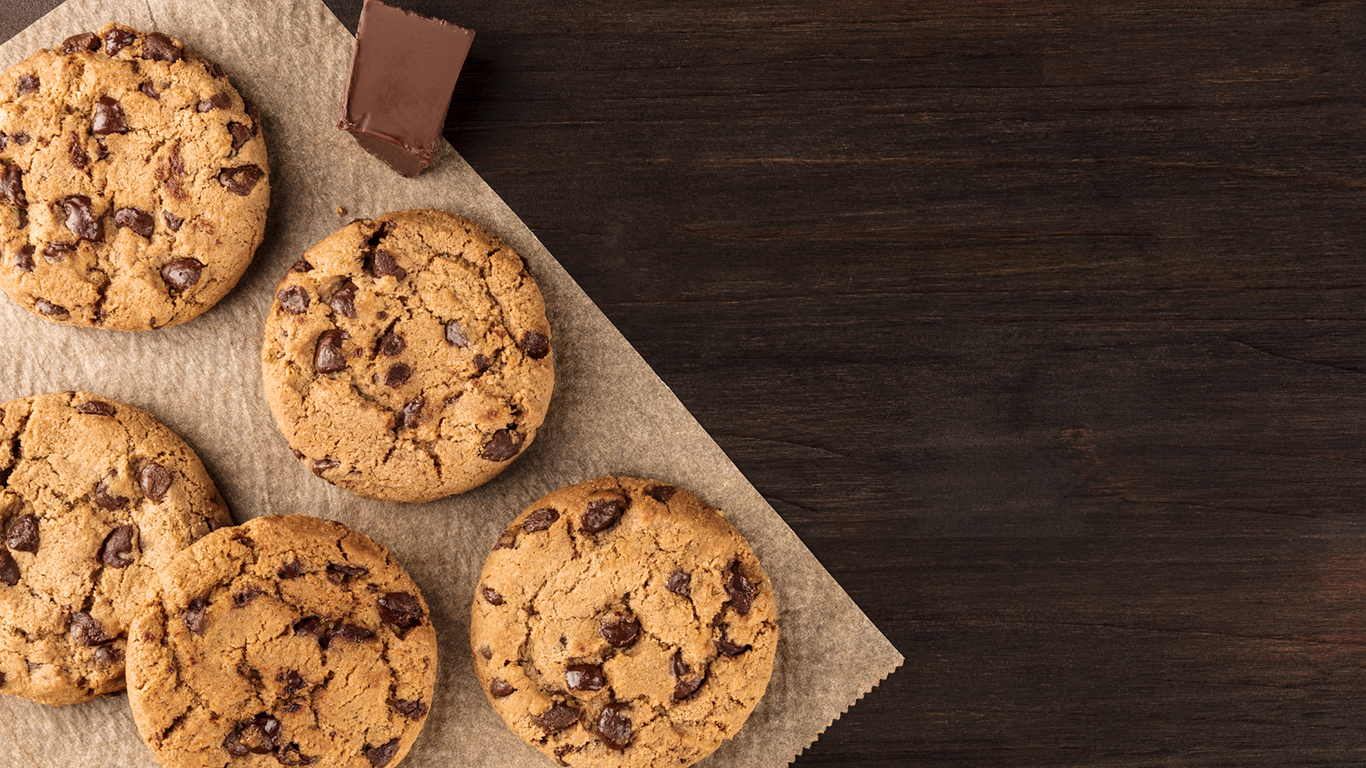
Cookies are irresistible. They’re easy to bake, relatively inexpensive to buy, and all too easy to eat. They’re small (usually), sweet, either crisp and crunchy or luxuriously tender and soft, and just indulgent enough. They satisfy sugar cravings without the heft of a piece of cake or a slice of pie.
In effect, cookies are cake — just on a smaller scale. The word itself comes from a Dutch word “koekje,” meaning, well, small cake. Why Dutch? Perhaps the influence of early Dutch settlers in New York and vicinity. In the U.K. and other English-speaking countries beyond our borders, what Americans call cookies are known as biscuits (from the Latin “bis coctis,” cooked twice — think biscotti). In this country, of course, a biscuit is a kind of small, crumbly leavened quick-bread roll — delicious, but not a cookie.
Food historians date the first cookie-like little cakes to seventh-century Persia, not surprising since that was one of the first countries to use sugar widely. It is thought that cookies were originally test cakes of a sort — small pieces of dough would be baked to test oven temperatures in the days before thermometers. Cookie recipes appeared in America as early as 1796.
Many of America’s most popular cookie brands — including Oreos, Fig Newtons, Lorna Doones, Nilla Wafers, and Mallomars — were developed by Nabisco in the late 19th or early 20th century. This bakery powerhouse, originally based in Chicago and later transported to New York City’s Chelsea neighborhood, was formed in 1898 through a merger of the American Biscuit Company (itself an agglomeration of some 40 independent Midwestern bakeries) and the New York Biscuit Company (formed out of nine East Coast bakeries). The new company was called the National Biscuit Company, abbreviated for decades as N.B.C. before the name Nabisco was adopted in 1941, in part to avoid confusion with the ascendent National Broadcasting Company — NBC — radio network.
However, some other cookie brands — and especially, for some reason, those specializing in chocolate chip cookies — were started on a shoestring by entrepreneurs. Still others were launched by once-competitive bakeries that have since gone out of business or been subsumed by large corporations.
Click here for the stories behind America’s favorite cookie brands.
One thing is certain: Cookies are big business in America and, increasingly, internationally as well. And many of them have interesting stories to tell.
Major food companies employ virtual armies of chefs, food scientists, and marketing gurus dedicated to developing new products. Some remain on the market for decades and others, though cherished by many, end up having a short life — these are 40 popular discontinued snacks we really miss.

1. Barnum’s Animals Crackers
> Debut: 1902
The earliest recipe for cookies formed into the shape of animals, originally known generically as “circus crackers,” or simply “animals,” apparently appeared in J. D. Hounihan’s “Secrets of the Bakers and Confectioners’ Trade,” self-published in Virginia in 1883. However, Stauffer’s Biscuit Company (now a division of Japan’s Meiji Co. Ltd.) claims to have produced the first ones in York, Pennsylvania, in 1871.
Nabisco branded its version, dating from 1902, with the name of showman and promoter P. T. Barnum, who, among other accomplishments, founded the Barnum & Bailey circus. The original packaging featured a string running from end to end because the cookies were sold at Christmastime, and the boxes were intended as tree ornaments. Some 37 different animals (some sources say 54) have been represented in the assortment over the years. This summer, in response to a campaign by PETA (People for the Ethical Treatment of Animals), Nabisco redesigned the packaging to show animals side by side in a grassland rather than in cages.
[in-text-ad]
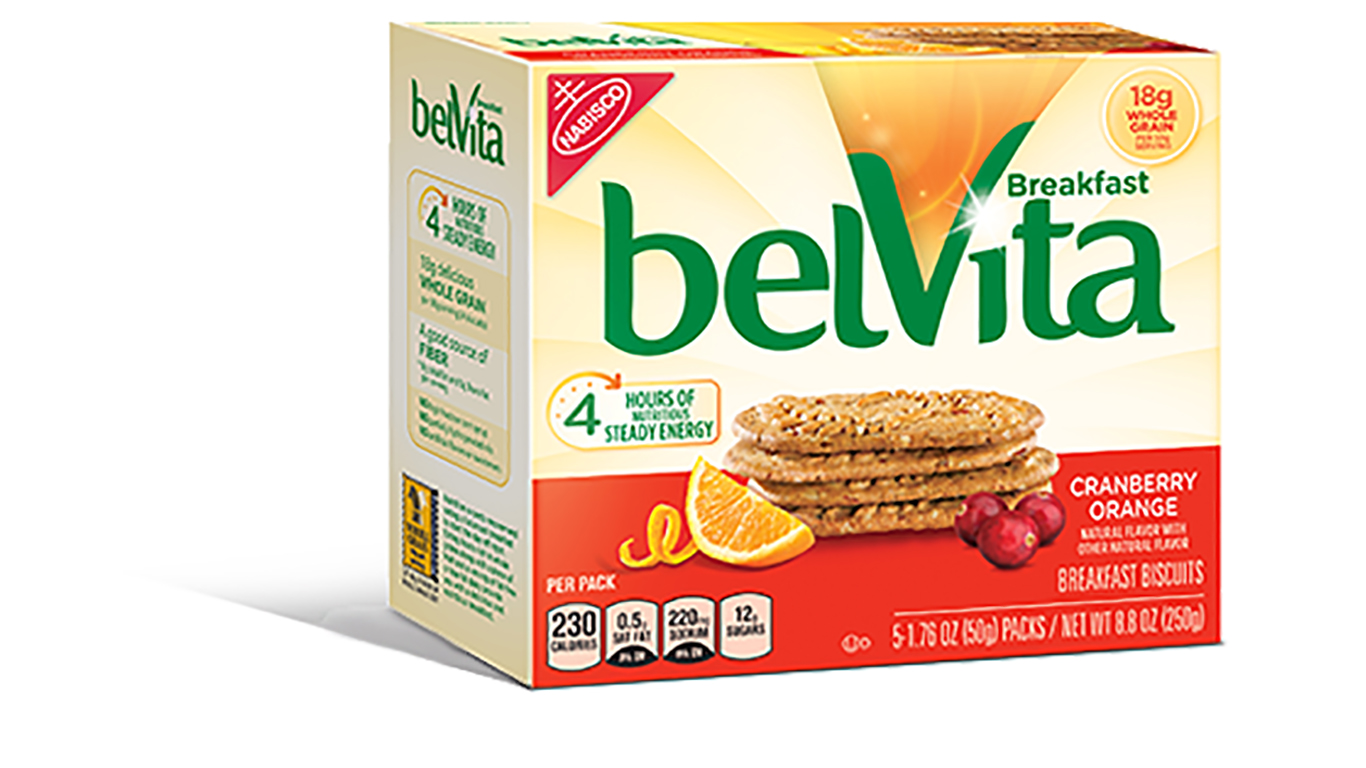
2. belVita Breakfast Biscuits
> Debut: 1998
These are crisp, slightly sweet, rounded-rectangular “biscuits” — the French word for cookie, a more accurate description of the product. BelVita Breakfast Biscuits originally launched in France in 1998 as Petit Déjeuner — “breakfast” in French — under Groupe Danone’s LU label. Research had shown that some consumers were already eating cookies at breakfast time, so the company — and subsequently other manufacturers — decided to design a product specifically for the purpose. (The biscuits go very well with coffee.) Kraft Foods bought Danone’s biscuit and cereal business in 2007, and three years later rebranded the biscuits as belVita. They first appeared in America in 2012 and racked $341 million in sales in the 12-month period ending Dec. 3, 2017.
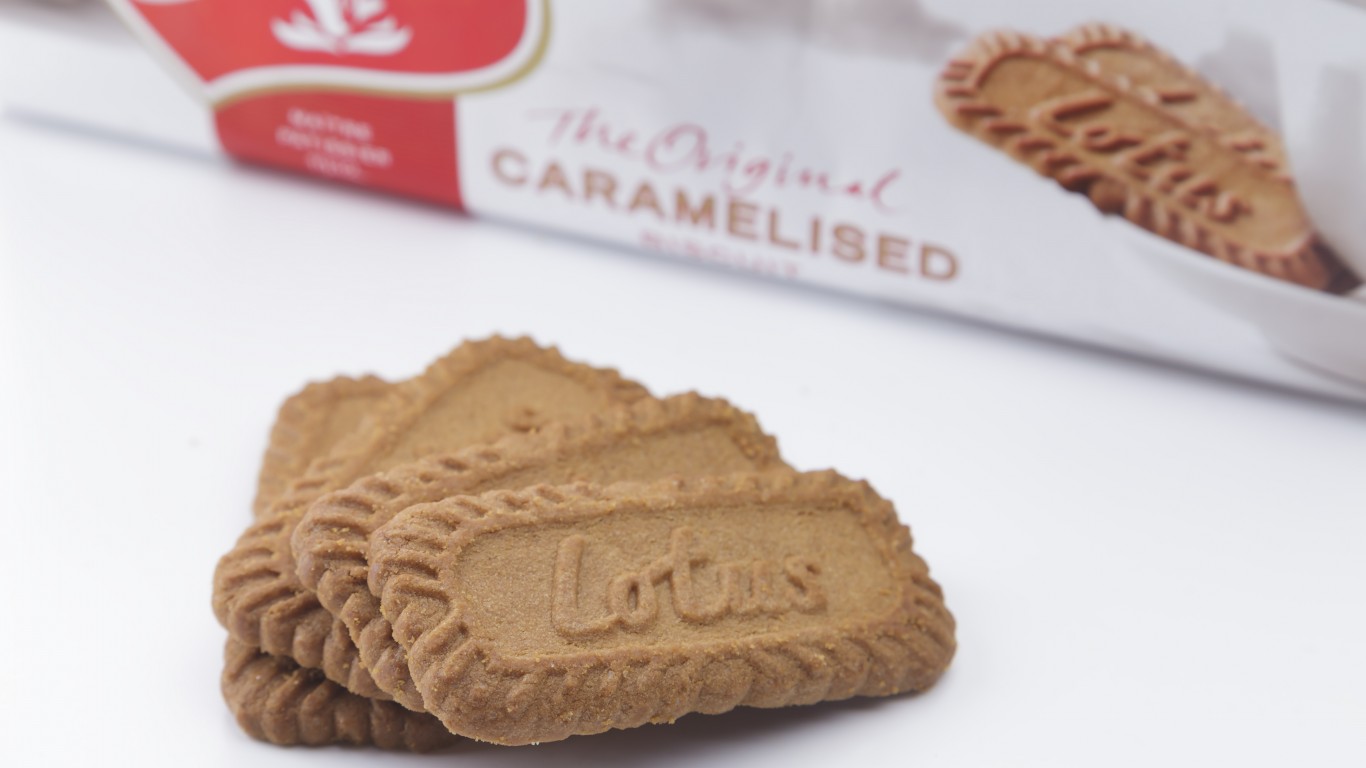
3. Biscoff Lotus
> Debut: 1932
The speculoos is a spiced, caramelized Belgian cookie, apparently dating back to 1870, and traditionally eaten on St. Nicholas Day (Dec. 6). In 1932, three brothers named Boone opened the Lotus bakery in the small Belgian farming town of Lembeke, 40 miles northwest of Brussels, specializing in two items — gingerbread and their version of speculoos. After World War II, the bakery phased out the gingerbread and had become the leading producer of speculoos worldwide by 1963. In the 1950s, the bakery began promoting the cookies as a perfect mate for coffee, and today, while they are still sold as speculoos in Europe, they’re labeled Biscoff — for “biscuit” and “coffee” — in the U.S. The cookies first came to this country in 1986 as in-flight airline samples, and they are now served on a majority of American-based airlines.

4. Chips Ahoy!
> Debut: 1963
There’s no folksy origin story here. The Chips Ahoy! brand was created in-house by Nabisco in 1963. In the early 1980s, when smaller scale cookie operations like Famous Amos, David’s Cookies, and Mrs. Fields began competing with larger brands, the company doubled the number of chocolate chips in every cookie, from 16 to 32 (later scaled back to 24). In the 1990s, ads proclaimed there were 1,000 chips in every bag. A third-grade arithmetic class in Wadesboro, North Carolina, famously challenged this count in 1996, finding a maximum of 680 chocolate chips in every bag they sampled. Nabisco responded that the students were counting only the chips visible on the surface of the cookies, and advised the children to soak the cookies in water so that the dough could be easily separated from the chips. Doing this and counting again, they found 1,181 chocolate chips in a bag — a finding reported everywhere from the Wall Street Journal to The Today Show. Chips Ahoy! sales jumped almost 20% as a result.
[in-text-ad-2]
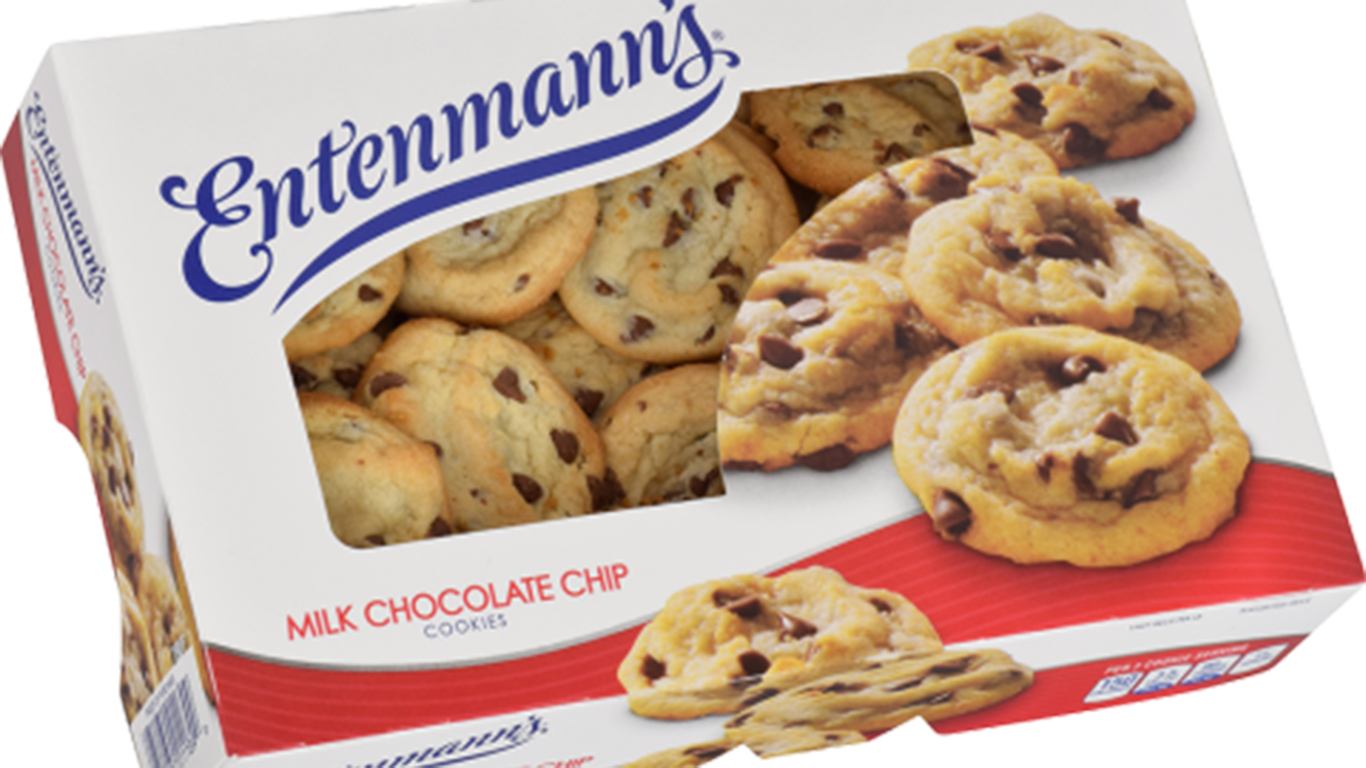
5. Entenmann’s Chocolate Chip Cookies
> Debut: 1974
German immigrant William Entenmann opened his first bakery in Brooklyn in 1898, and later moved the operation to Long Island. The business expanded into Connecticut, New Jersey, Florida, the Midwest, and the West Coast, remaining under family control until 1978, when it was sold to the pharmaceutical company Warner-Lambert. It is now owned by Mexico’s Grupo Bimbo, the world’s largest baking company. In 1974, after establishing a reputation for such products as apple pie, chocolate doughnuts, and the popular All Butter Loaf Cake, Entenmann’s introduced chocolate chip cookies, using chocolate made in-house. Since then, more than 620 million cookies have been sold.
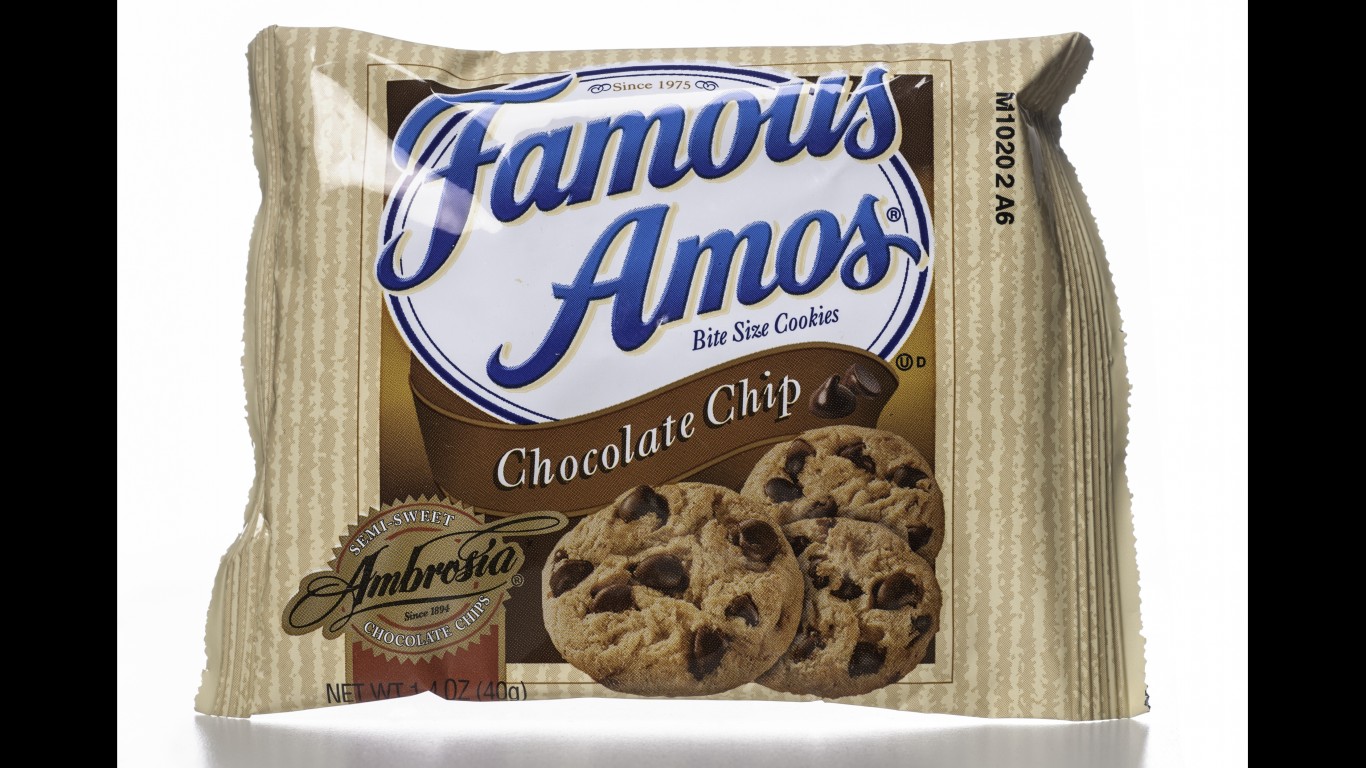
6. Famous Amos Chocolate Chip Cookies
> Debut: 1975
Wally (Famous) Amos was a talent agent at the William Morris Agency in New York City — he signed Simon & Garfunkel and represented the Supremes and Dionne Warwick, among others — but he left the business in 1967 and moved to Los Angeles. After attempts to set up his own management business there failed, he came up with another plan. Using his schooling — he had studied culinary arts at a vocational high school in New York for a couple of years — and his Aunt Della’s home-baked chocolate chip cookies, he thought he’d try to make a living with his version of her recipe.
With backing from Marvin Gaye and Helen Reddy, friends from his agency days, he opened a cookie stand on Sunset Boulevard. He promoted his brand with images of himself, smiling and sporting a panama hat and embroidered shirt, and did $300,000 worth of business in his first year. By 1982, revenue had reached $12 million. Amos wasn’t an accomplished businessman, though, and was forced to sell off part of his company in 1985. In 1988, the company lost $2.5 million, and in 1998, after several interim owners, Famous Amos was bought by Keebler.
[in-text-ad]
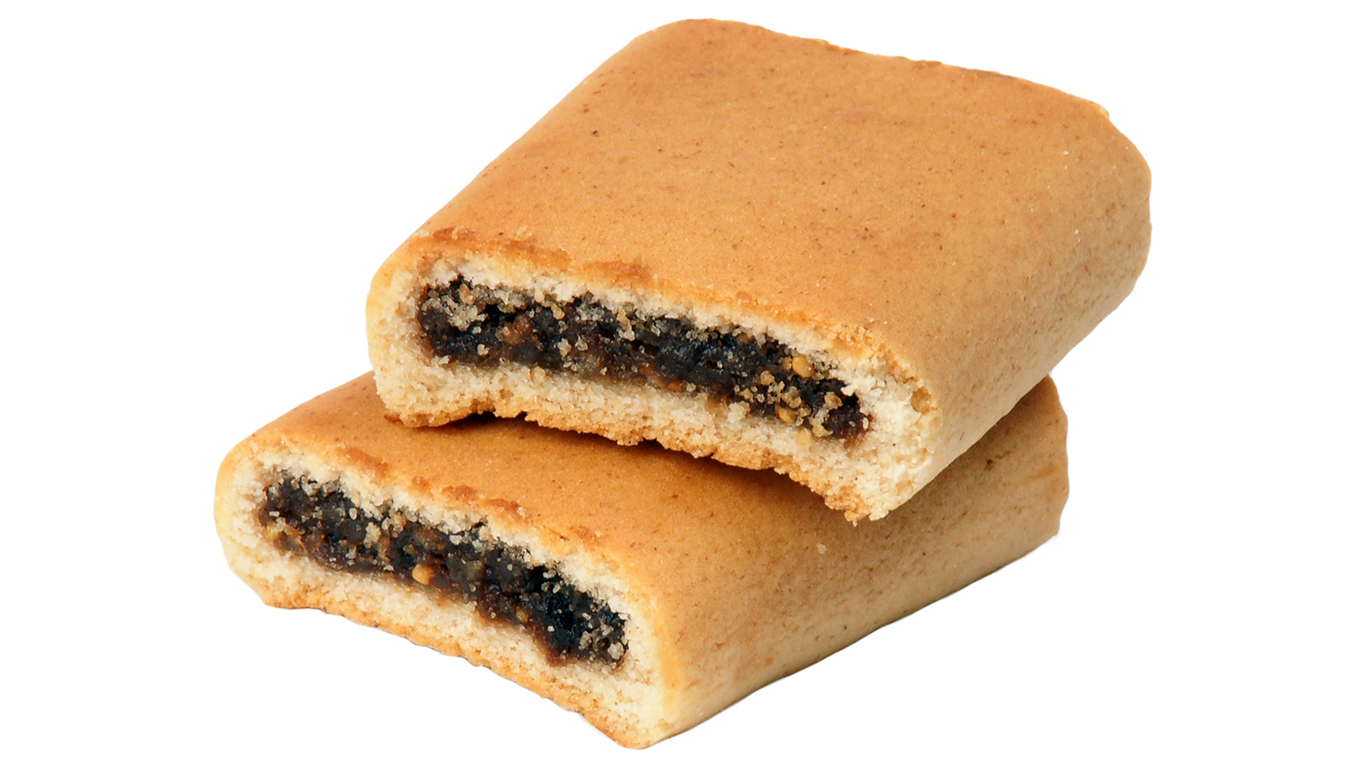
7. Fig Newtons
> Debut: 1891
Actually, Fig Newtons aren’t called “Fig Newtons” anymore, though that’s how many people still think of them. The idea of fig jam enclosed in a soft, cake-like dough dates back to the late 19th century, but there are competing claims as to who invented the cookie. One version of the story credits an Ohio-born cookie maker named Charles Roser, said to have invented a machine in Philadelphia around 1891 that allowed the jam to be funneled into the dough as it was made. Another version credits Floridian James Henry Mitchell with developing the technology. It is also possible that Roser came up with the idea for the cookie, while Mitchell created the machine that could mass-produce it.
In any case, Roser sold the recipe to the Kennedy Biscuit Company of Cambridgeport, Massachusetts, which began producing Fig Newtons — or just Newtons, as they were originally called — almost immediately. The cookie was apparently named not for mathematician and physicist Isaac Newton, as is sometimes said, but for the Boston suburb of Newton. (The company already had cookies with other Boston-related names, including Harvard and Beacon Hill.)
In 1898, when the National Biscuit Company (later abbreviated to Nabisco) was formed, it took over the Kennedy Biscuit Company and its cookies. Newtons were renamed Fig Newtons in acknowledgement of their filling, but in 2012, “Fig” was dropped from the name again because the product was being made with other kinds of fruit besides the original, and also perhaps because the company feared that figs, like prunes, were associated with older people, not the younger market they hoped to capture.
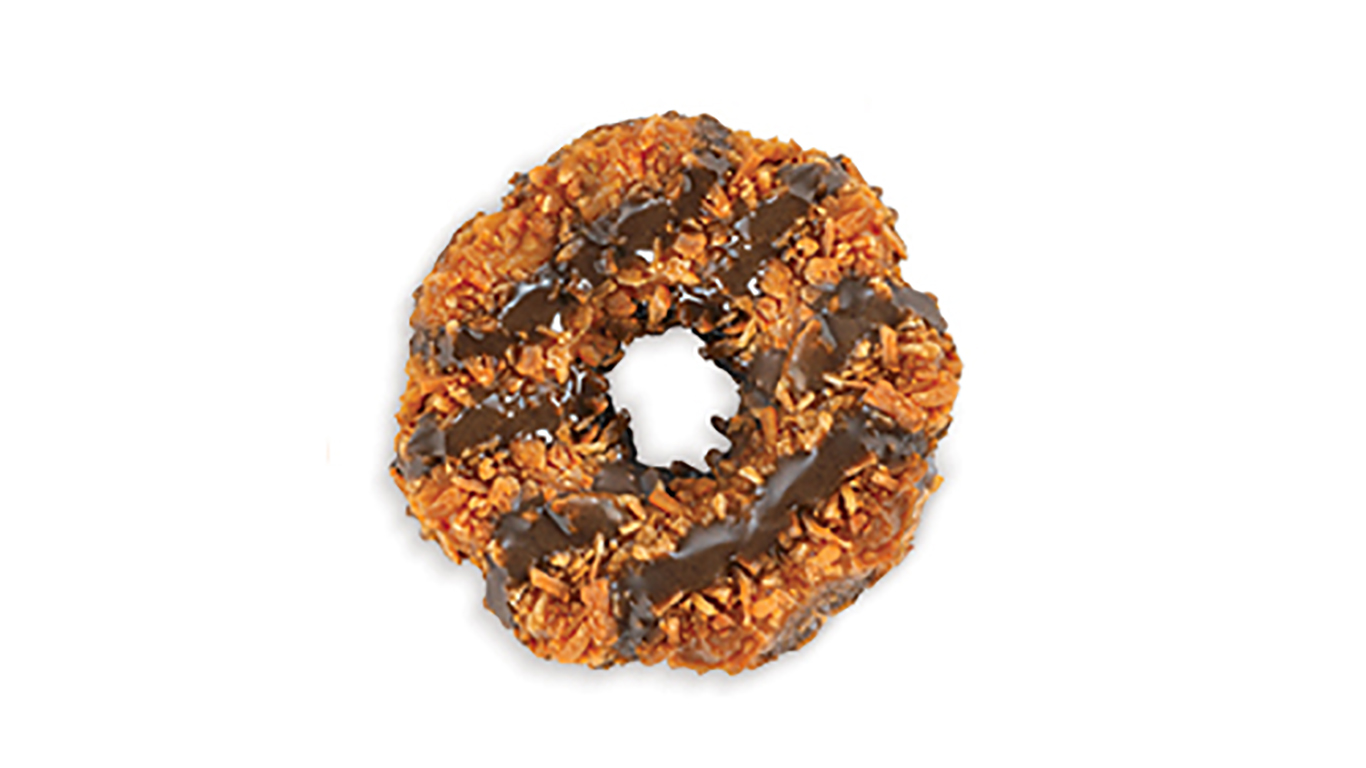
8. Girl Scout Samoas (aka Caramel deLites)
> Debut: 1975
The Girl Scouts first sold cookies, as far as anyone knows, in 1917, when a troop in Muskogee, Oklahoma, baked some to sell in their school cafeteria to fund their projects. In 1935, cookies were first marketed under the Girl Scout label, and the following year, the Scouts signed up commercial bakers to help meet the growing demand. By 1948, some 29 bakeries were producing the cookies.
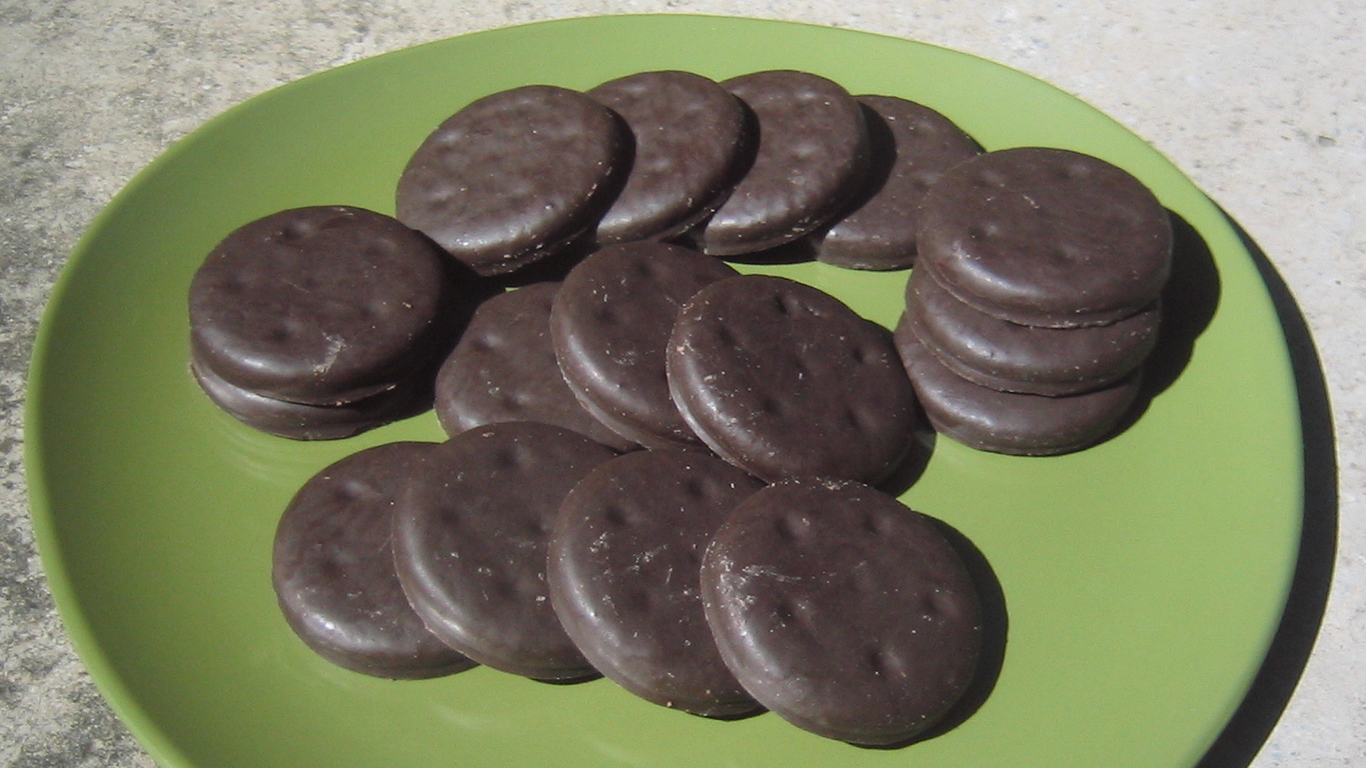
9. Girl Scout Thin Mints
> Debut: 1939
Thin Mints, originally called Cooky-Mints, were introduced to the Girl Scout lineup in 1939. Since then, a Girl Scout historian told Time Magazine, the name has changed to Chocolate Mint to Thin Mint to Cookie Mint to Chocolate Mint to Thin Mints (plural) to Thin Mint and finally back to the plural form. While a number of Girl Scout Cookie varieties go under different names according to which of the two official bakeries produces them (see No. 8), Thin Mints are always Thin Mints. However, the Little Brownie version has a richer, smoother chocolate coating than ABC’s.
[in-text-ad-2]
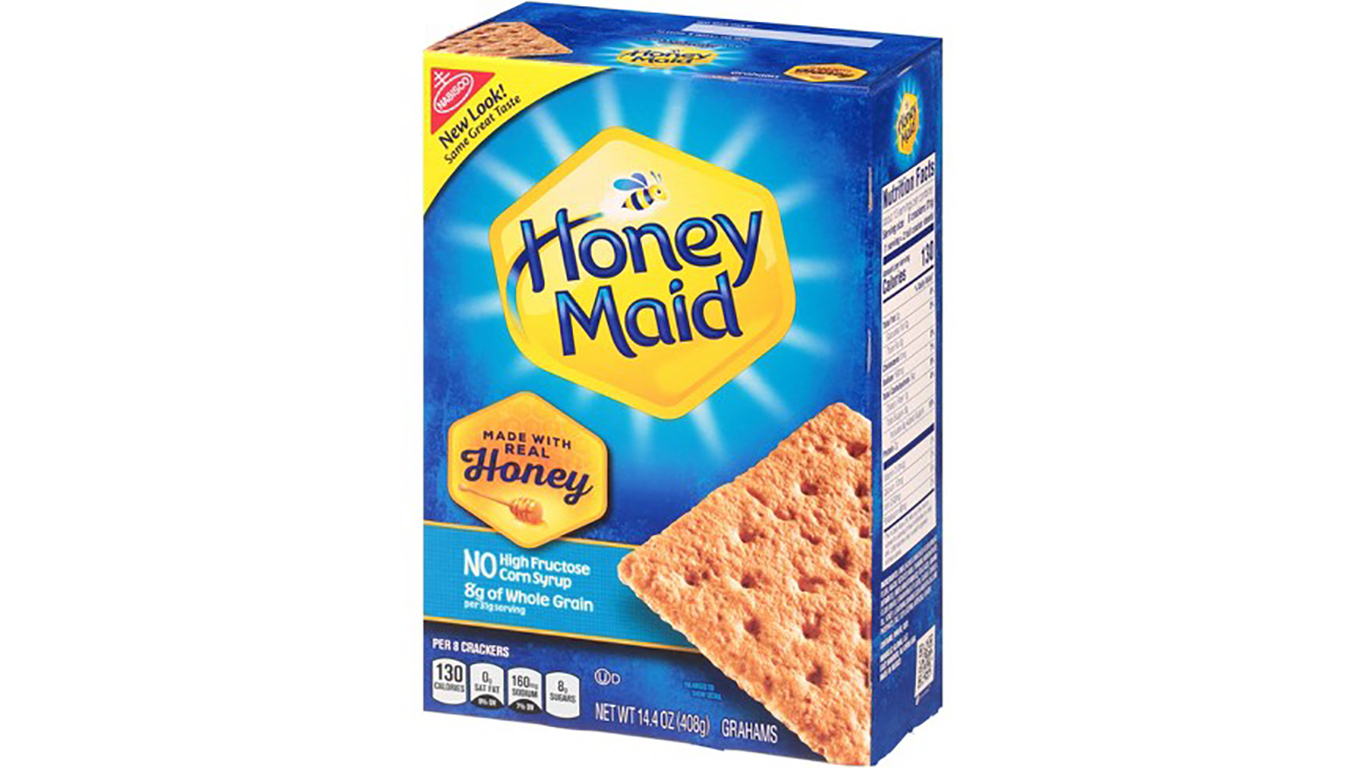
10. Honey Maid Graham Crackers
> Debut: 1925
The Connecticut-born Presbyterian minister, social reformer, and health-food advocate Sylvester Graham (1794–1851) was a vegetarian who believed that certain foods (like meat) stimulated the libido — a bad thing, in his view. He wrote a book about bread, and maintained that white flour was unhealthy. Graham himself may or may not have invented the crackers that today bear his name — recipes didn’t begin appearing in cookbooks until three decades after his death — but they were originally made with the coarse whole wheat flour he espoused. Though a number of bakers were producing graham crackers, as they had come to be called, by the early 1900s, Nabisco’s version became particularly popular because the company softened the recipe with honey. The first Honey Maid grahams were made by Seattle’s Pacific Coast Biscuit Company in 1925. Nabisco bought the bakery five years later, and kept the name.

11. Keebler E. L. Fudge Original Cookies
> Debut: 1987
Godfrey Keebler, a German immigrant baker, opened a small neighborhood shop in Philadelphia in 1853. Keebler’s enterprise grew, and in 1926, it became part of the United Biscuit Company of America, headquartered in Chicago. In 1966, the company was renamed Keebler Co. and moved to suburban Elmhurst. Since 2001, it has been part of the Kellogg Co.
The first Keebler elf, dubbed J.J. Keebler, introduced in 1969, was the creation of Chicago’s Leo Burnett Co. ad agency. Ernest J. “Ernie” Keebler appeared not long afterwards, soon joined by others to supposedly make Keebler products in Hollow Tree Bakery, located in a hollow tree. When Keebler introduced the elf-shaped E. L. Fudge cookie in 1987, consumers noticed that the brand’s initials spell “ELF.” However, in early commercials, Ernie reveals that it the “E. L.” stands for “Everybody Loves.”
[in-text-ad]
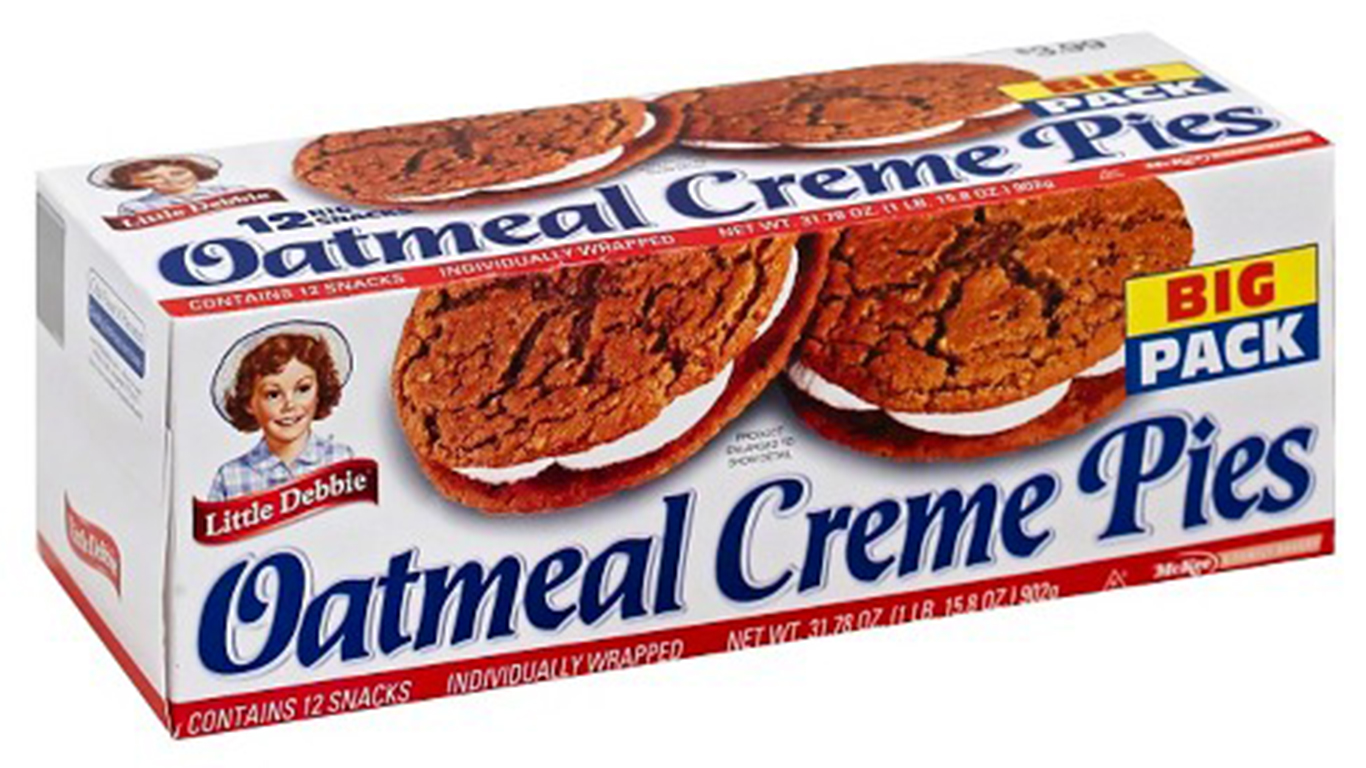
12. Little Debbie Oatmeal Creme Pies
> Debut: 1960
Little Debbie’s parent company, McKee Foods Corporation, was founded in 1934 when O.D. and Ruth McKee bought a small bakery in Chattanooga, Tennessee, and started producing snack cakes. The McKees struggled for decades, until O.D. decided to market some of his products individually wrapped but packaged in multi-snack cartons. One of his suppliers suggested naming the new line after a family member. He thought of his 4-year-old granddaughter Debbie, and the Little Debbie brand was born.
The first product sold under that label, which debuted in 1960, was the Oatmeal Creme Pie, which the company describes as a snack cake but is really a cookie sandwich — two oatmeal cookies separated by a sweetened cream filling.
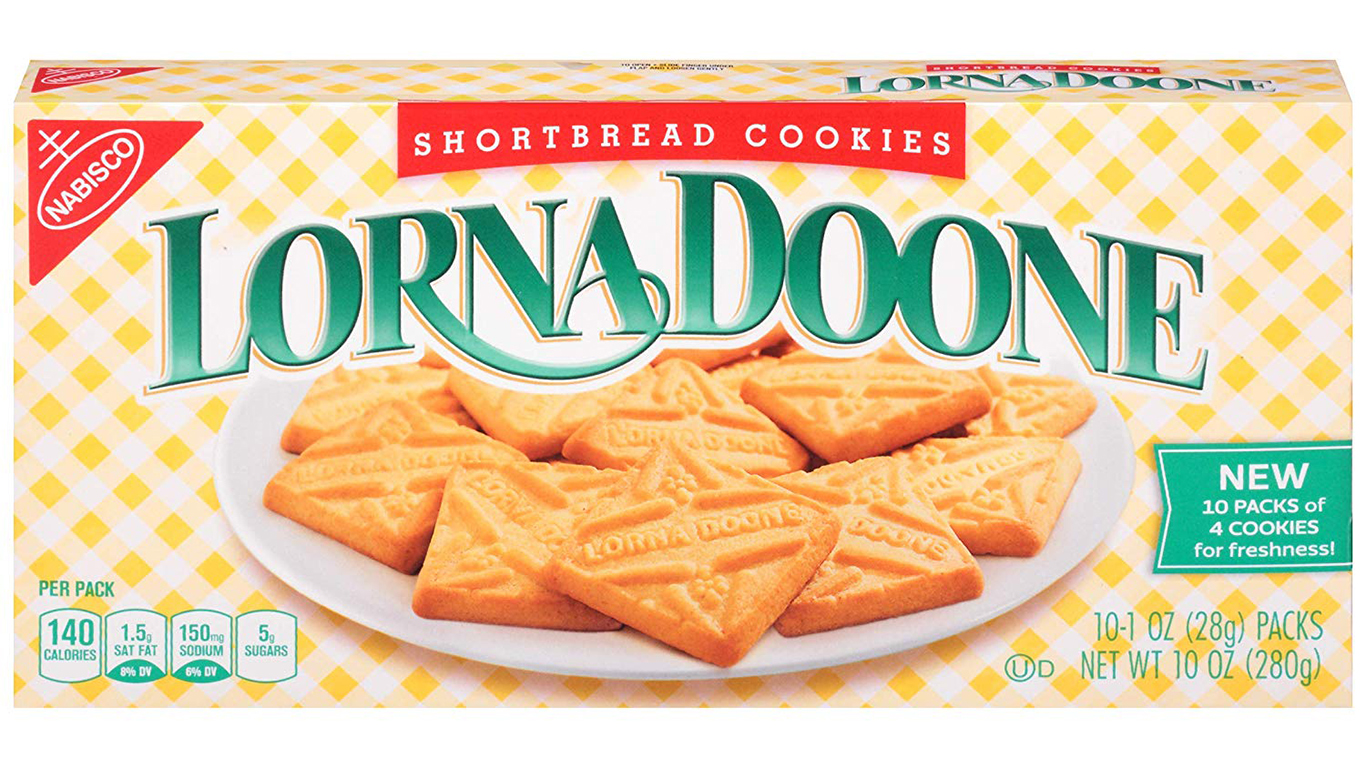
13. Lorna Doone Shortbread Cookies
> Debut: 1912
Nabisco released these rectangular shortbread cookies the same year that Oreos first appeared. An oft-repeated origin story for Lorna Doones has it that a Nabisco employee from Pittsburgh, Pennsylvania, named Joe Howat gave his Scottish-born mother’s shortbread recipe to the company. The account given by the Inner-Seal Collectors Club — an organization of Nabisco memorabilia collectors — doesn’t mention Howat, however. According to the club’s website, Nabisco wanted to sell a shortbread cookie but had trouble producing it on a mass scale. One Frank Werner, president of the Werner Machine Company in Detroit, loved shortbread and developed a means of molding the cookies with wooden blocks. He either sold Nabisco the technology or the company developed its own version. The usual story is that because shortbread is Scottish in origin, the company named the new cookies after a popular Scottish novel, “Lorna Doone.” The only problem is that the book’s author, R. D. Blackmore, was English, and though the Doone family was of Scottish origin, the entire novel takes place in Exmoor, in southwestern England.
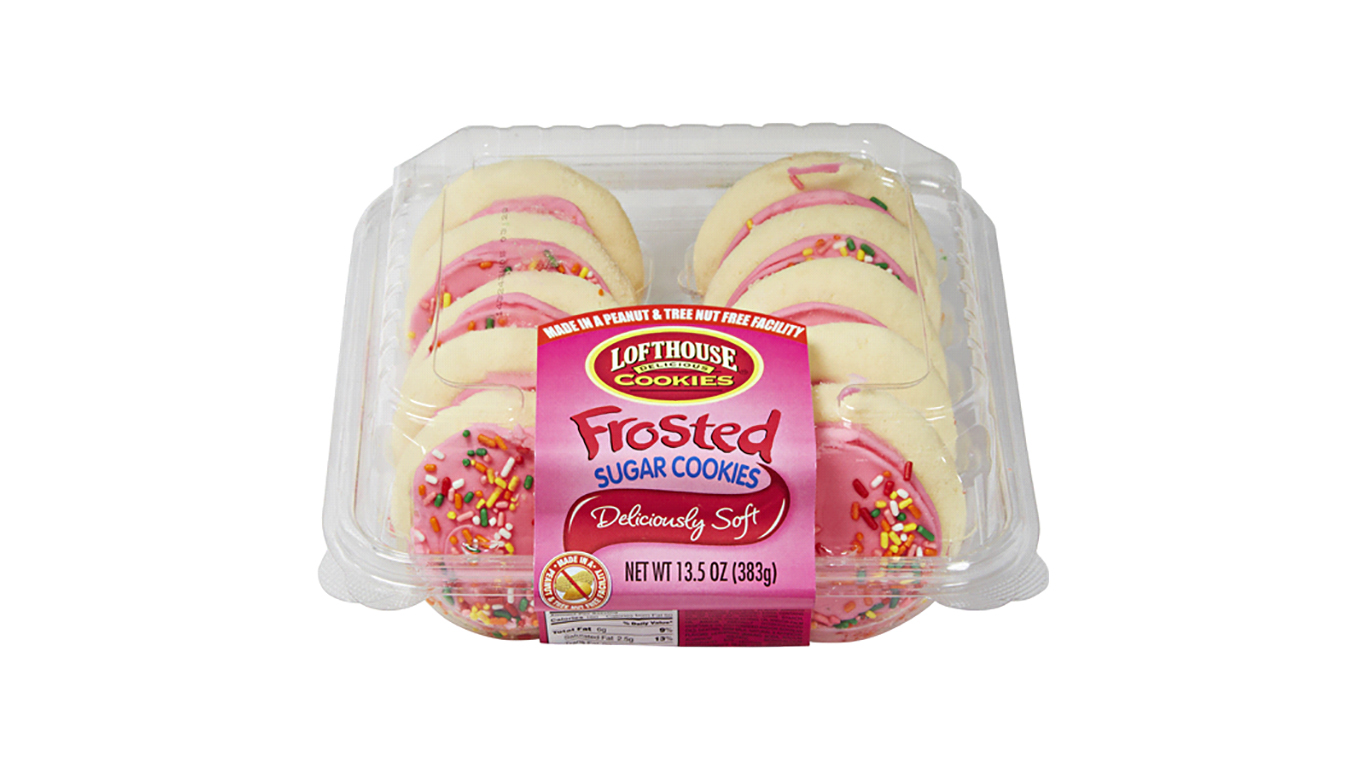
14. Lofthouse Frosted Sugar Cookies
> Debut: 1995
In 1995, Dave and DeAnn Stone, a couple from Farmington, Utah, north of Salt Lake City, launched what is now a popular, ubiquitous grocery store cookie brand out of a small kitchen in nearby Ogden. They baked by night and sold their wares personally to local convenience stores during the day. Though the line has since vastly expanded, the original sugar cookie — soft and chewy, with thick pink frosting covered with multi-color sprinkles — remains Lofthouse’s signature. Since 2012, the company has been owned by ConAgra Foods, whose brands include Hunt’s, Marie Callender’s, and Chef Boyardee, among many others.)
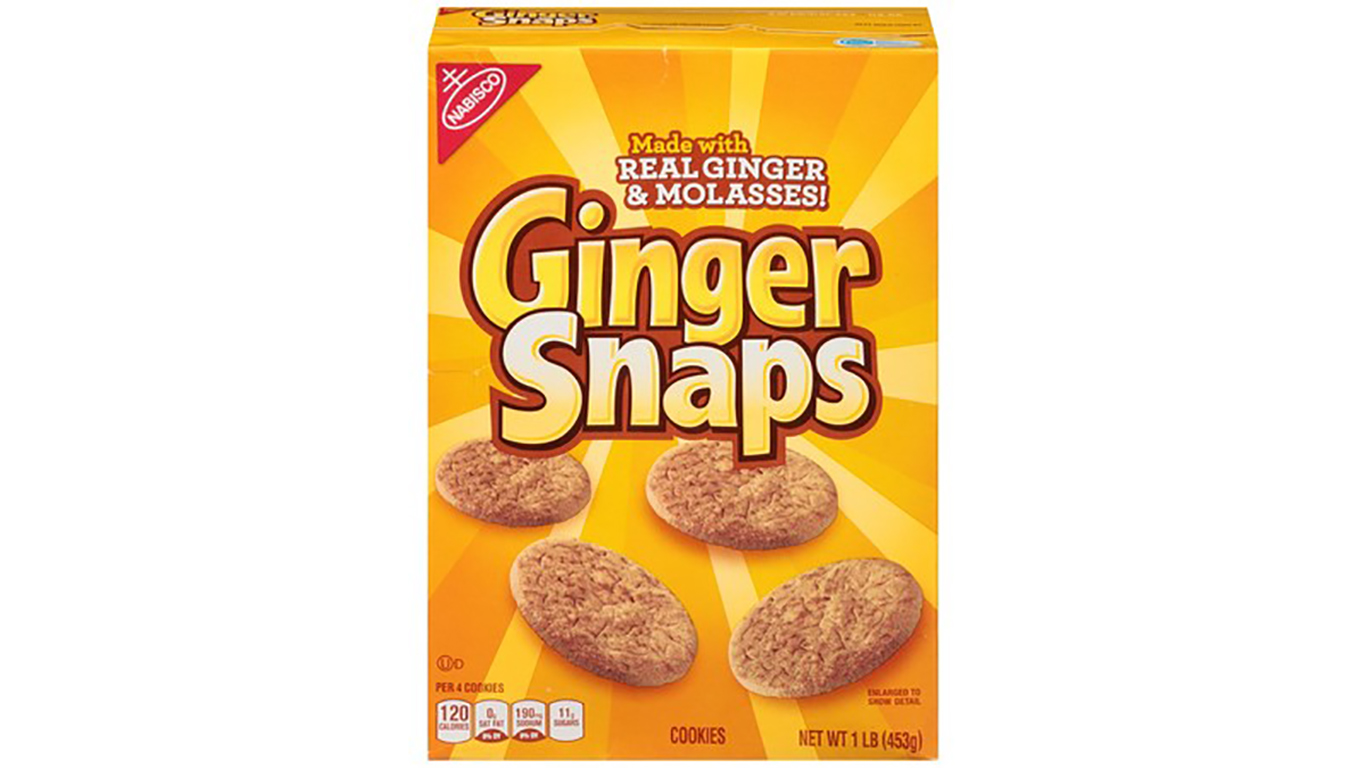
15. Nabisco Ginger Snaps
> Debut: 1901
The first ginger snaps (sometimes written as one word) were made centuries ago in Germany and England, probably as variations on gingerbread. Sweetened with molasses, they really do contain ginger. Why they’re called “snaps,” though, is the subject of conjecture. It might be simply because they’re crisp cookies that snap when they’re broken in two, or the word might derive from the German “schnappen,” meaning to grab quickly.
Nabisco rolled out its version of the cookie early in the company’s existence under the name Zu Zu Ginger Snaps. Described as “a spicy combination of ginger and sugar-cane molasses,” they came in packages picturing a clown named Zu Zu. The name is said to have been inspired by the character Zulu from a play called “Forbidden Fruit” by Irish playwright Dion Boucicault. At some point in the 1970s, Nabisco dropped the Zu Zu branding, and the cookies are today known simply as Ginger Snaps.
[in-text-ad-2]
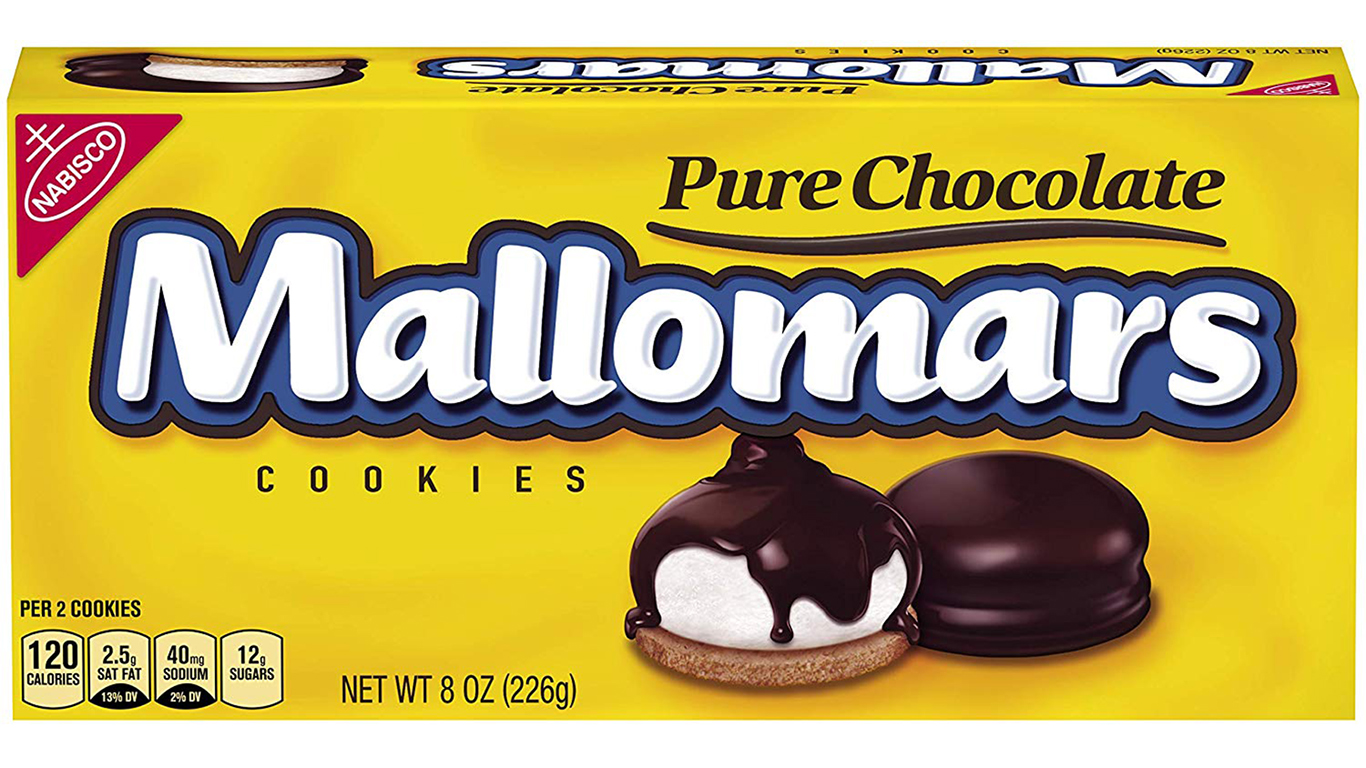
16. Mallomars
> Debut: 1913
Yet another invention by Nabisco, these graham crackers topped with marshmallow and coated in chocolate were created in Manhattan and originally sold in New Jersey to a grocer in what is now Union City. Mondelēz International, Nabisco’s parent company, now produces them exclusively at a facility in Toronto — though they are not sold in Canada. When the cookies were first introduced, they were sold only in cooler weather, from September through March, because they were prone to melting in the heat. That may not be a problem in this era of refrigerated trucking and ubiquitously air-conditioned stores, but the company maintains the tradition. Some 85% of Mallomars are consumed in the New York Tri-State area.

17. Mrs. Fields Chocolate Chip Cookies
> Debut: 1977
Debbi Fields was a young Northern California housewife who, after a year or so of marriage, decided to start a business based around the chocolate chip cookies she had been baking since the age of 13. Fields had gradually adapted the original 1930s-vintage Toll House chocolate chip cookie recipe, and her version was big and soft. Market research had suggested that customers preferred crisp cookies, and her friends and relatives didn’t believe her cookies would do well. Nonetheless, she and her economist husband found a banker who was willing to give them a business loan, and in 1977, when she was only 20, she opened Mrs. Fields’ Chocolate Chippery in Palo Alto’s Liddicoat’s Market. Failing to sell any cookies, she took samples out into the street. Once people had tasted them, they came to buy the cookies.
By early 1981, there were 14 Mrs. Fields’ stores in several states; by 1983, there were 70. The chain continued to grow, but over-expansion and the economic downturn of the 1990s affected the chain, and the Fieldses increasingly lost control of their company. The couple divorced in the late 1990s, and in 2000, the company was sold to Famous Brands International, an arm of investment firm Z Capital Partners (Famous Brands also owns the TCBY frozen yogurt chain). Debbi Fields remains a spokesperson for the company, which currently has more than 300 retail outlets in the U.S. and internationally.
[in-text-ad]
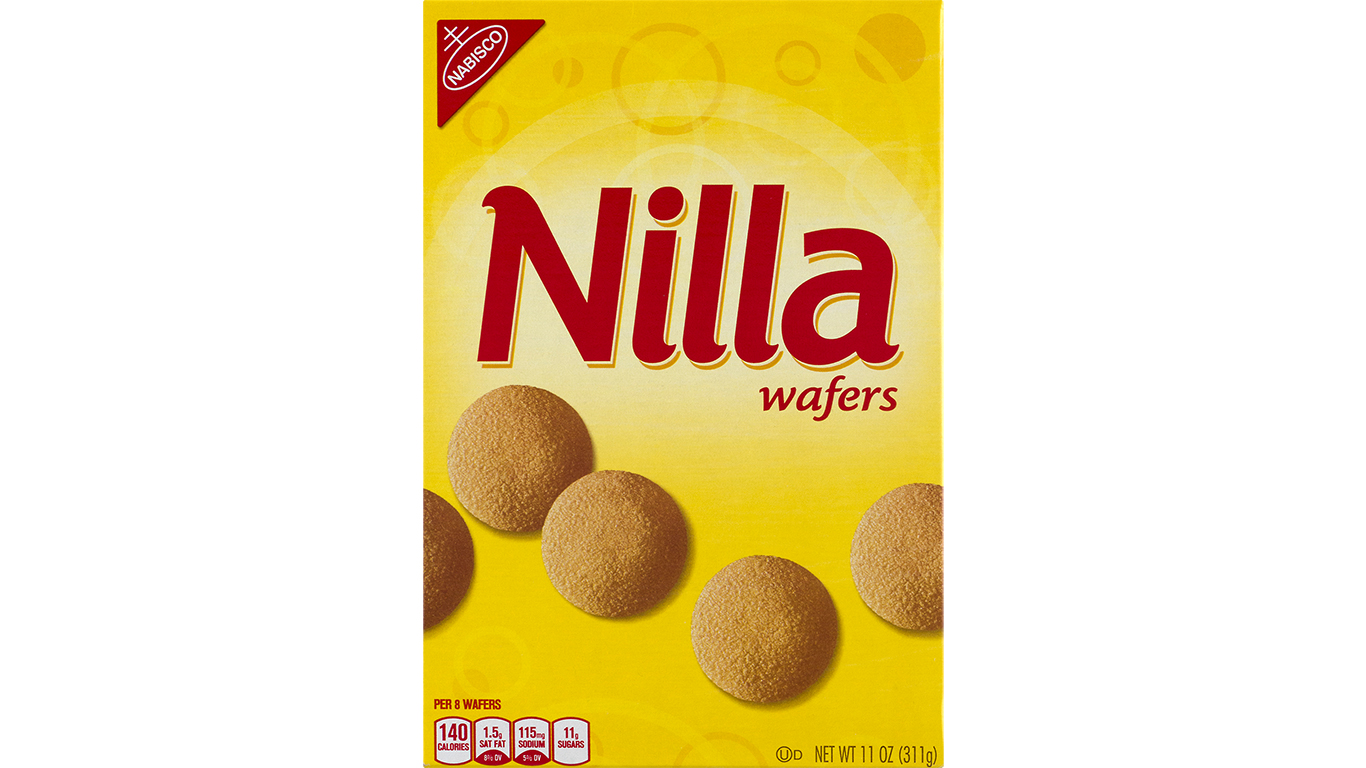
18. Nilla Wafers
> Debut: 1898
Though vanilla wafers were being sold in the New York area as early as 1871, the original recipe for what evolved into Nilla Wafers is said to have been devised in the late 19th century by a Staten Island confectioner named Gustav A. Mayer, who sold the formula to Nabisco. That company began marketing them in 1898, calling them simply Vanilla Wafers. They were rebranded under the Nilla name only in 1967. In the 1920s, home cooks started using the wafers to make a kind of bottom crust for banana pudding, and in the 1940s, Nabisco began publishing a recipe for the dessert on its vanilla wafer boxes. It became particularly popular in the American South, and today, banana pudding made with Nilla Wafers is considered a Southern culinary icon.
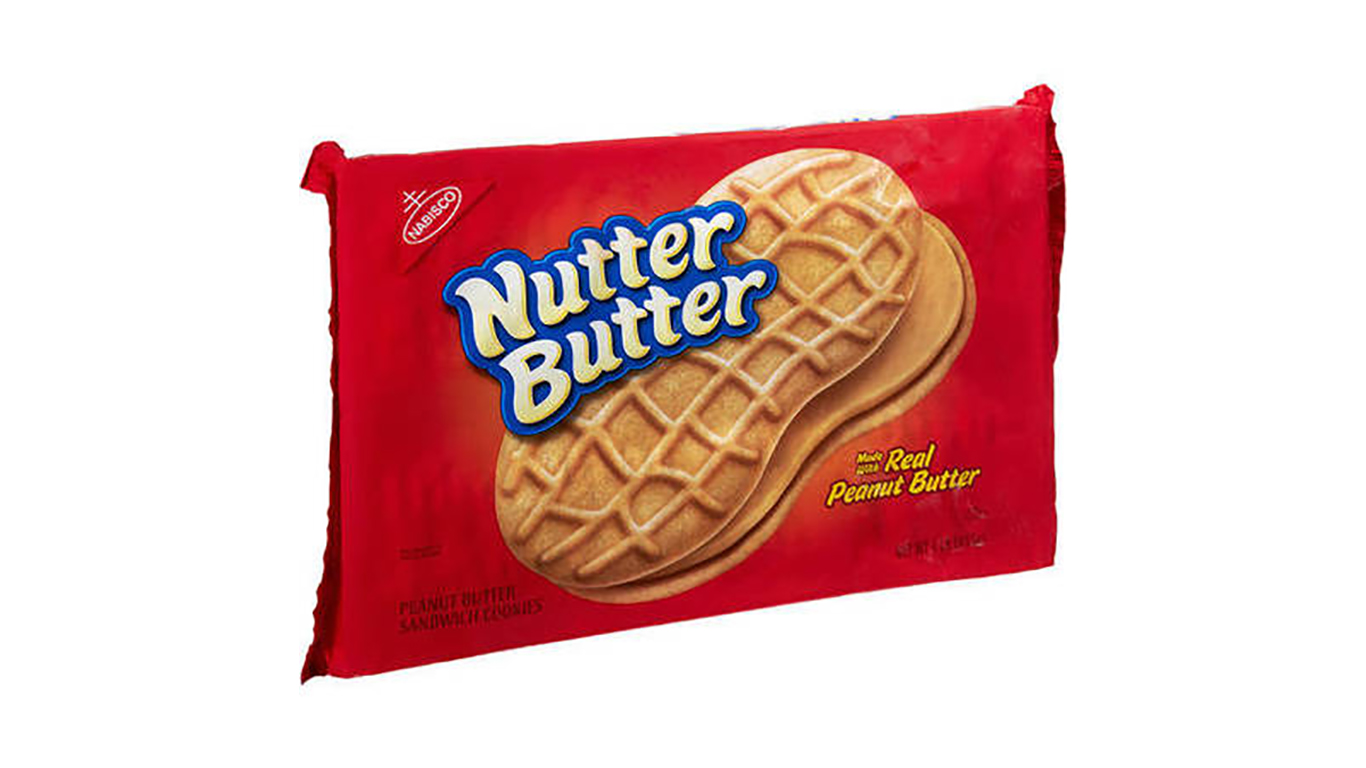
19. Nutter Butter
> Debut: 1969
Nutter Butter wafers are another cookie concoction developed by Nabisco. Consisting of two sugar wafers shaped more or less like peanuts in their shell, sandwiching a “real peanut butter” filling. The company styles them, on the package, “The peanut butter lovers’ cookie.” Cookie trivia: The waffle pattern on the wafers was designed by William Turnier, who worked in Nabisco’s engineering department — the same man who redesigned the surfaces of Oreos (See No. 20) 40 years after their debut and tweaked the appearance of both Ritz Crackers and Milk-Bones.
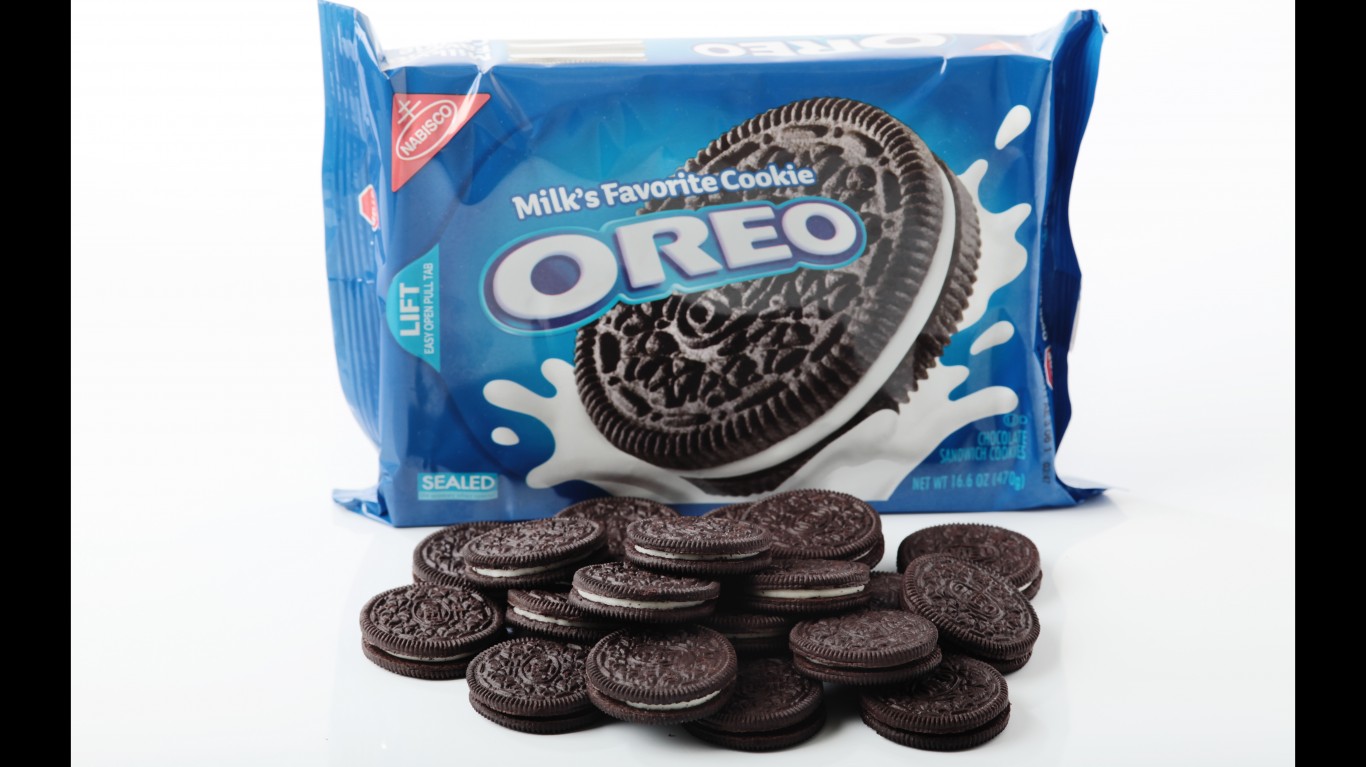
20. Oreos
> Debut: 1912
The world’s best-selling cookie, Oreos sales top $2 billion annually worldwide. More than 40 billion of them are produced each year in — countless seasonal, promotional, and regional varieties — in some 18 countries. (Oreos’ biggest market, after the U.S., is China.) Oreos were first made in Nabisco’s Manhattan factory and initially sold in bulk tins, by weight (a grocer in Hoboken, New Jersey, was the first customer). The origin of the name is uncertain, but it may derive from the Spanish word for gold, “oro” as early packaging had gold lettering, or perhaps from the Greek word for mountain, “óros” because the first Oreos were reportedly mound-shaped.
Oreos weren’t the original cookie of their kind. The Sunshine Biscuit Company created a confection that looked almost exactly like Oreos in 1908, called Hydrox, four years before the first Oreo was made — but Nabisco’s superior marketing apparatus turned its version into a smash hit, while Hydrox gradually faded from the scene. (Sunshine was bought by Keebler in 1996 and is now part of the Kellogg’s empire.)
[in-text-ad-2]
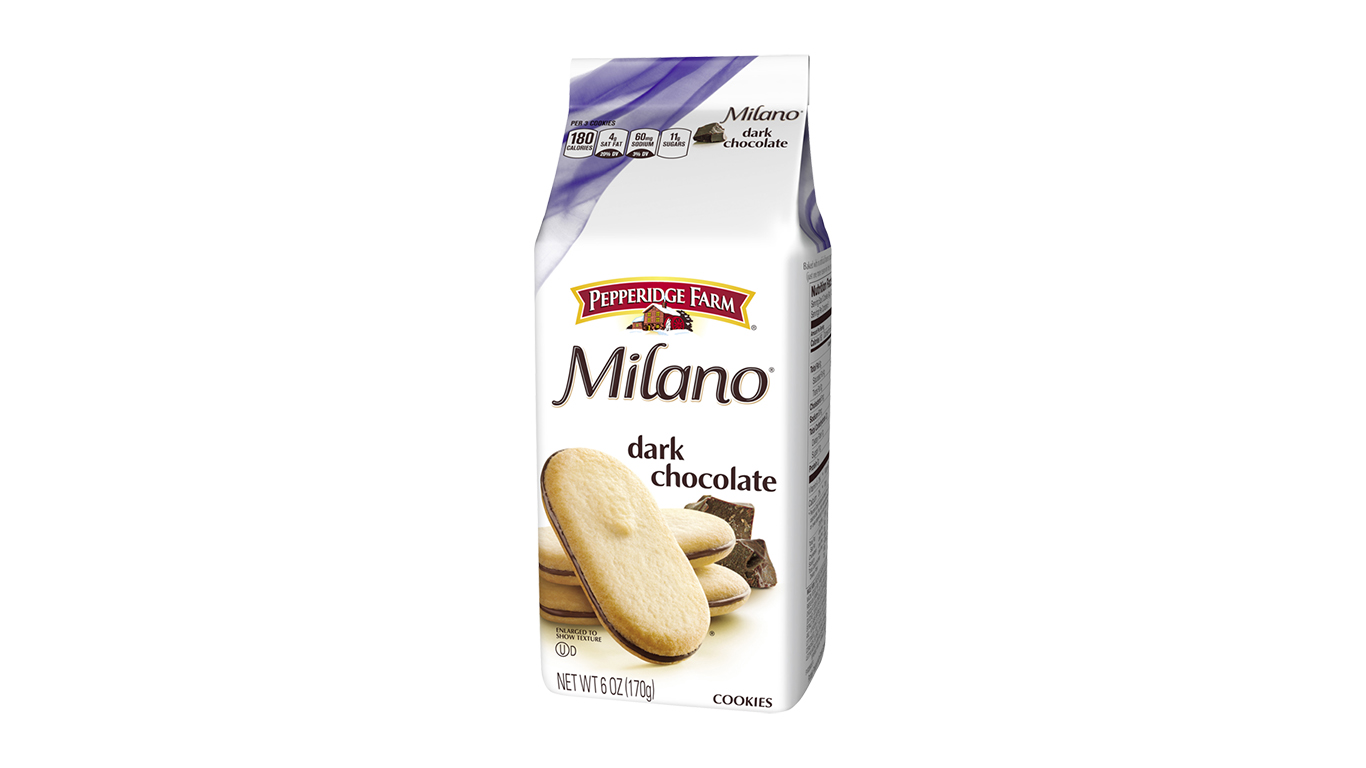
21. Pepperidge Farm Milano
> Debut: 1957
There really was a Pepperidge Farm, a property in Fairfield, Connecticut. There, during the Depression, housewife Margaret Rudkin started baking whole grain bread for an ailing son. The bread turned out so well that she began selling it, first locally, then in New York City. The enterprise grew, and on a trip to Europe, the Rudkins discovered a line of fancy chocolate cookies being produced in Belgium by N.V. Biscuit Delacre. Thinking they could be popular in America, Rudkin bought the rights. One of the varieties evolved into the Milano — a sandwich of chocolate cream (dark, milk, and mint-flavored versions are available) enclosed in sugar cookies of the type the French call “langue de chat,” or cat’s tongue, for their shape. (Pepperidge Farm has been owned by the Campbell Soup Company since 1961.)
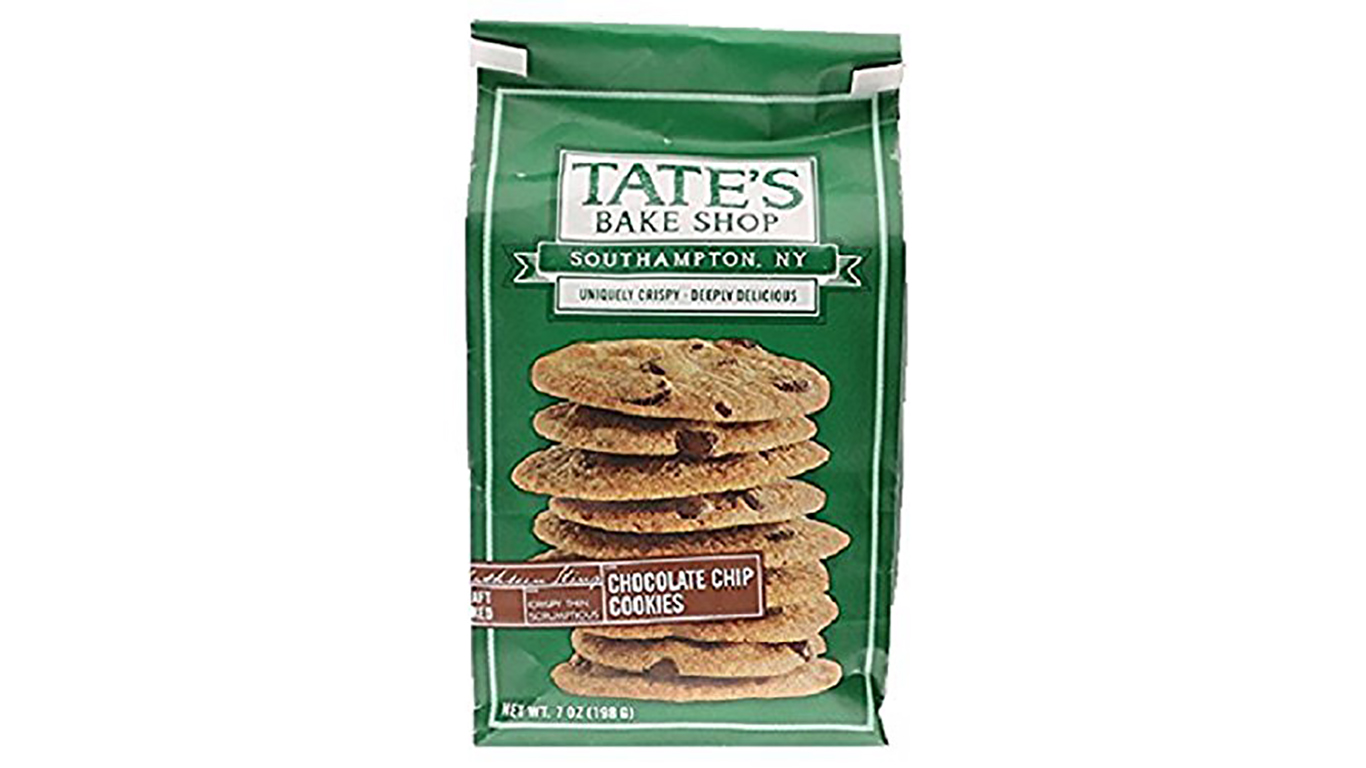
22. Tate’s Chocolate Chip Cookies
> Debut: 1980/2000
Kathleen King got her start baking at the age of 11, making chocolate chip cookies from the recipe on the Nestle’s chocolate chip bag to sell at her family’s North Sea Farms farmstand in Southampton, Long Island (the farm is still going strong under King family ownership, selling holiday turkeys as well as produce). In 1980, at the age of 21, King decided to go pro and opened Kathleen’s Cookie, soon renamed Kathleen’s Bake Shop, in Southampton. The business grew, but in 1999, King ended up in debt after a partnership deal failed, and she lost her building and the right to use her name to sell cookies.
She was able to get the building back and turned a former school in nearby East Moriches into a 45,000-square-foot bakery. Because she could no longer brand her cookies with her own name, she dubbed her resurrected company Tate’s, after her father’s nickname. The cookies — very crisp and buttery — grew from a cult favorite into a ubiquitous supermarket brand. In 2014, King sold a majority interest in Tate’s to the Riverside Company, a global private equity firm, for $100 million. In 2018, Riverside in turn sold the interest to Mondelēz International (also parent company of Nabisco) for about $500 million.
In 20 Years, I Haven’t Seen A Cash Back Card This Good
After two decades of reviewing financial products I haven’t seen anything like this. Credit card companies are at war, handing out free rewards and benefits to win the best customers.
A good cash back card can be worth thousands of dollars a year in free money, not to mention other perks like travel, insurance, and access to fancy lounges.
Our top pick today pays up to 5% cash back, a $200 bonus on top, and $0 annual fee. Click here to apply before they stop offering rewards this generous.
Flywheel Publishing has partnered with CardRatings for our coverage of credit card products. Flywheel Publishing and CardRatings may receive a commission from card issuers.
Thank you for reading! Have some feedback for us?
Contact the 24/7 Wall St. editorial team.
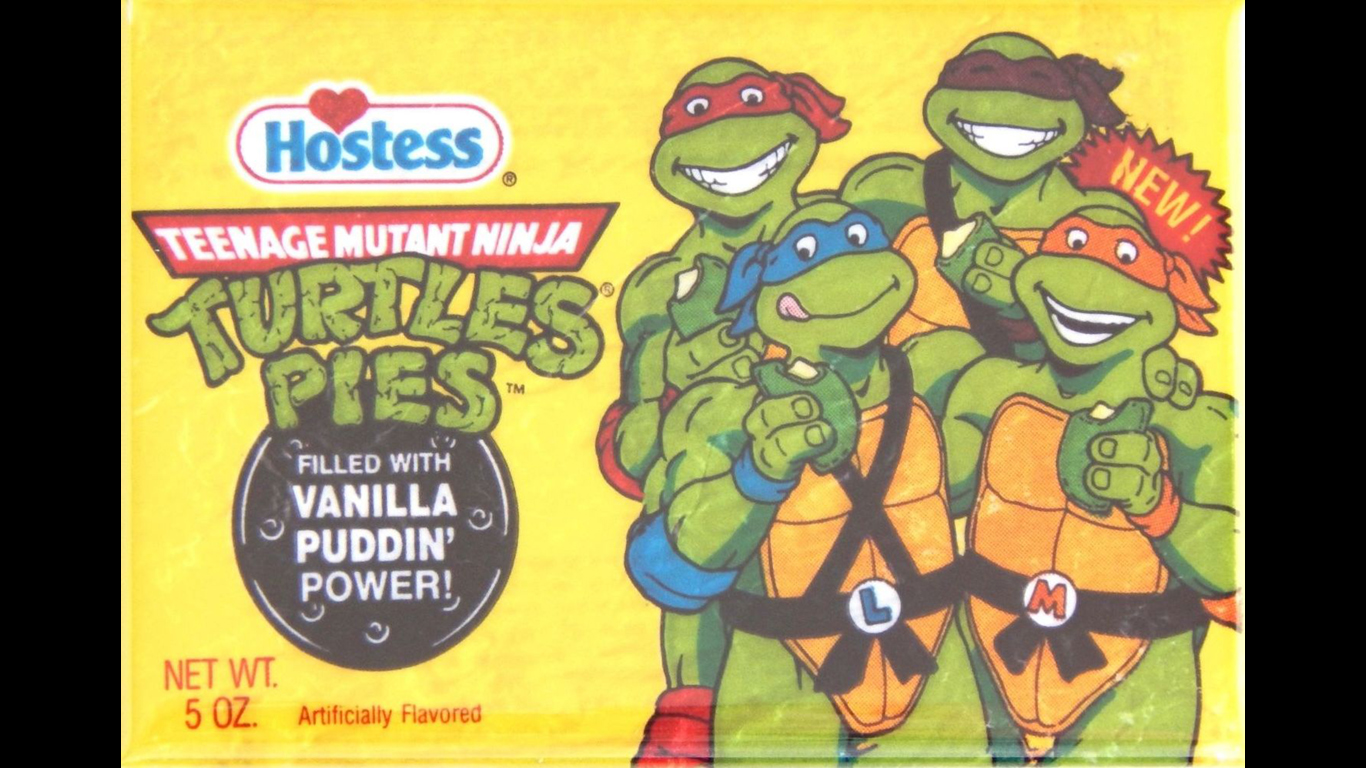 24/7 Wall St.
24/7 Wall St. 24/7 Wall St.
24/7 Wall St. 24/7 Wall St.
24/7 Wall St.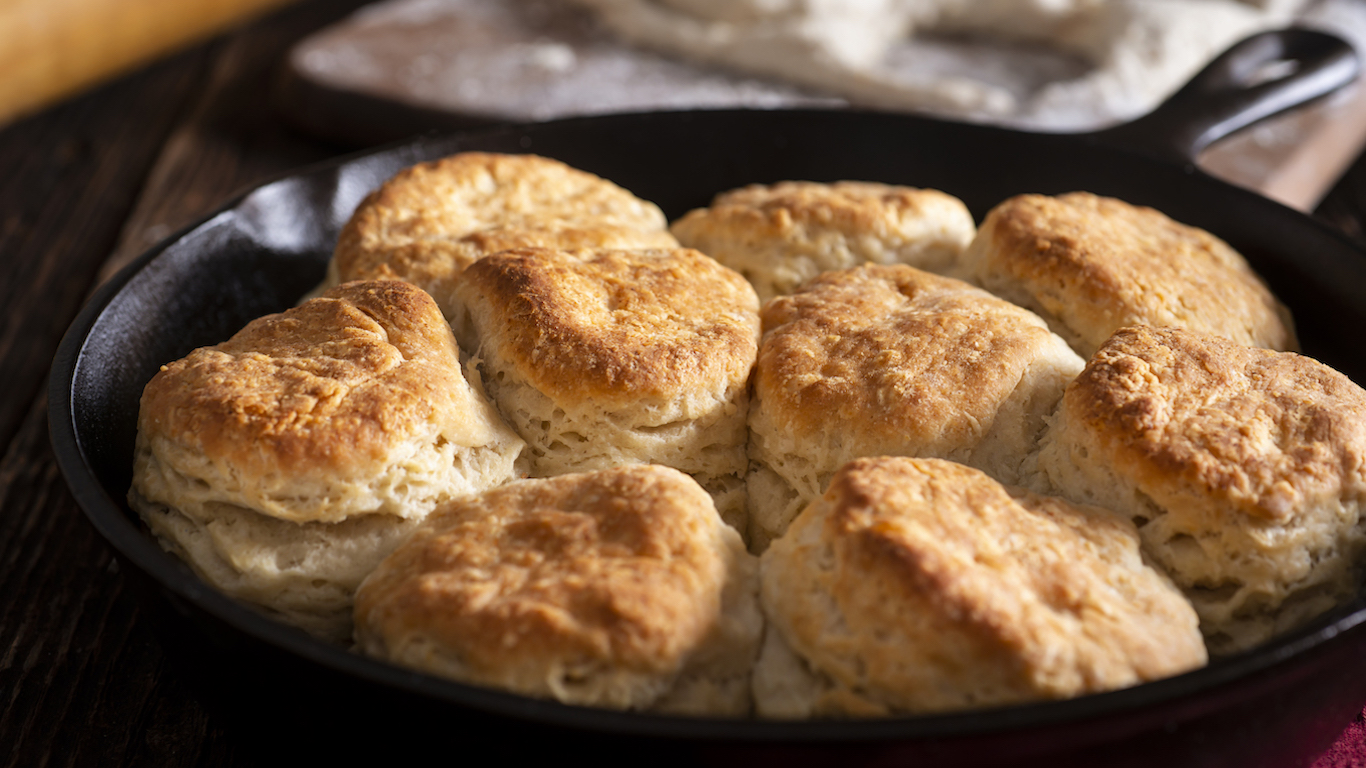 24/7 Wall St.
24/7 Wall St.

